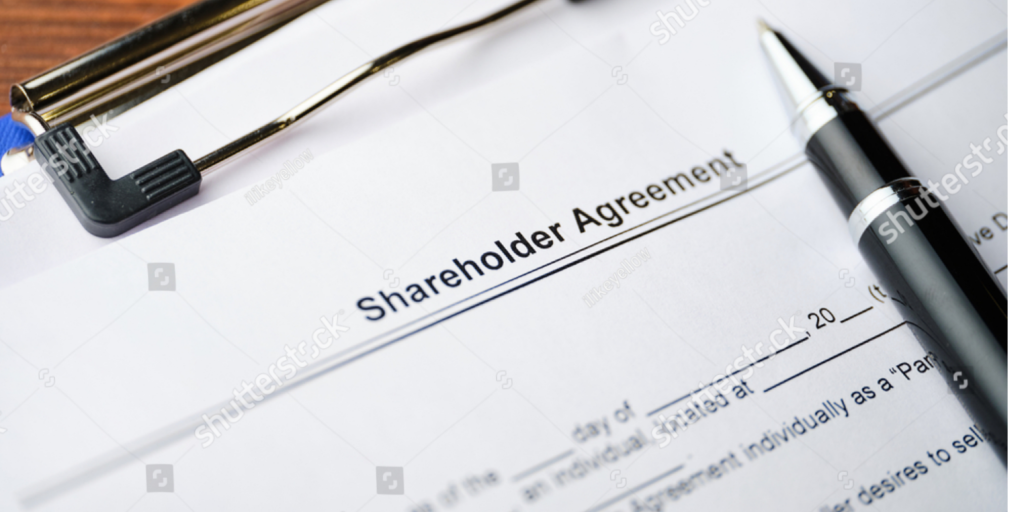There is no legal requirement to have a shareholders’ agreement in place when you set up a company limited by shares. Nevertheless, a properly drafted agreement is strongly recommended in any company that has more than one shareholder.
We begin this post by briefly explaining the purpose of a shareholders’ agreement, before discussing the key features and provisions that most companies include, such as shareholder rights and dispute resolution procedures.
What is a shareholders’ agreement?
A shareholders’ agreement is a private contract between the members of a company limited by shares. Supplemental to the articles of association, it outlines the rights and obligations of the shareholders and regulates the way in which the company is run.
Whilst this type of agreement may seem unnecessary in smaller companies, particularly when going into business with family or friends, it pays to be pragmatic, because you never know what might happen further down the line.
Putting a shareholders’ agreement in place at the very beginning protects members’ interests and those of the company. It minimises the risk of disputes and sets out clear procedures for dealing with various situations that may arise in the future.
What should be included in a shareholders’ agreement?
The contents of a shareholders’ agreement vary from company to company. What to include depends on several factors, such as the number of shareholders, the division of ownership and control, the size and nature of the business, and long-term plans.
While articles of association outline the statutory rules by which a company must abide, a shareholders’ agreement provides extra clarity and protection specific to a particular company.
Since this type of agreement is optional, there are no particular provisions that must be included. However, most shareholders’ agreements will typically cover the following areas outlined below:
1. Ownership, rights, and obligations
A shareholders’ agreement usually starts off with basic details, such as the date of its creation, the company name and registered office, the names of all shareholders, details of their shareholdings, and how much capital they have invested or agreed to invest in the company.
It is also important to set out the prescribed particulars of rights attached to shares, as well as any additional shareholder rights and responsibilities. These include:
- Voting rights – whether they are entitled to vote on company decisions and, if so, under what circumstances
- Dividend rights – their right to receive a share of the profits by way of dividend payments
- Capital rights – whether they are entitled to a share of any remaining capital if the company is wound up
- Dividend policy – when dividends can and cannot be declared, and what percentage of post-tax profits can be distributed within a specified period
- Limited liability – the extent to which each member is personally responsible for company debts
- Information rights – their right to access certain company documents
Typically, the agreement will also provide additional information on the role of each shareholder, for example, whether they are also directors or hold some other active position within the company.
2. Decision making
Under the Model articles of association, which most new companies adopt, directors have the power to make day-to-day business decisions without shareholder approval. Unless the shareholders are also directors, problems can arise if there is a difference of opinion between the company’s members and the board of directors.
In either case, including certain conditions and restrictions within a shareholders’ agreement can limit the decision-making powers of directors and provide greater control to shareholders.
For example, setting out a list of reserved matters that require shareholder approval, providing shareholders with the right to veto certain board decisions, and the rules relating to general meetings.
To provide additional protection to minority shareholders, some companies may also stipulate that particular decisions require unanimous consent, rather than majority approval.
3. Issuing and transferring shares
Rules and restrictions on the allotment and transfer of shares are commonplace in shareholders’ agreements. Such provisions are crucial for protecting the interests of the company and its members.
Specific clauses related to shares normally include pre-emption rights, which give existing members the right of first refusal on any shares that become available, relative to their current percentage of ownership. This prevents the involuntary dilution of each member’s stake in the company.
- Rules and restrictions on share transfers in a private limited company
- Can shares be transferred to children?
- A guide to transferring and issuing company shares
In many companies, directors have the authority to issue more shares without shareholder approval. To ensure members retain control over such decisions, a shareholders’ agreement can specify that any new allotment of shares requires the consent of members.
A shareholders’ agreement may also include drag-along rights, that force minority shareholders to sell their shares if a specified majority wishes to sell the company. Similarly, an agreement may contain tag-along rights, which enable minority shareholders to sell their shares on the same terms as majority shareholders.
4. Dispute resolution procedures
Whilst business relations may be sunshine and roses in the beginning, there’s no telling what may happen in the future. Unfortunately, disagreements between business partners are relatively common, so it makes sense to plan for the worst.
Providing clear dispute resolution procedures within a shareholders’ agreement is an inexpensive and effective way to deal with disagreements, such as 50/50 deadlocks, before they get out of hand or cause irreparable damage to the business.
Typically, the affected parties will begin with mediation, with a view to reaching a mutually agreeable solution without recourse to full litigation or a complete breakdown of the company.
5. Exit clauses
There are many reasons why shareholders leave a company, including retirement, resignation, expulsion, or disagreement. In some cases, the cause may be the death of the shareholder.
Whatever the reason behind a member’s exit from a company, the situation can become unnecessarily complex and costly in the absence of appropriate provisions and procedures.
Exit clauses, with clearly defined rules on the transfer of shares in such situations, can facilitate a smooth transition, protect the interests of the company and its remaining shareholders, and minimise the risk of drawn-out disputes.
Some companies also include ‘bad leaver’ provisions, which stipulate that any exiting member who is in serious breach of their contractual obligations may not receive full market value for their shareholdings.
6. Restrictive covenants
Restrictive covenants prevent shareholders from competing with the company and poaching its employees, clients, and key suppliers whilst they are members, and for a specified period of time after leaving the company.
These types of clauses protect companies from being undermined, particularly those operating within industries that rely on specialist knowledge (e.g. tech) or personal contacts (e.g. recruitment).
How and when to create this agreement
You can create a shareholders’ agreement at any time – even years after setting up a company. Ideally, however, you should put one in place before you begin trading. By doing so, you have an opportunity to clarify members’ expectations and identify any requirements or potential issues that may have been overlooked.
It is possible to draft a shareholders’ agreement yourself, but we would always recommend seeking professional advice and assistance from a corporate solicitor. They will work through different options and help you to create an agreement that is tailored to your particular circumstances, protects the interests of all members, and aligns with your company’s articles of association.
Do I need to file a shareholders’ agreement with Companies House?
A shareholders’ agreement is a private contract between the members of a company. You do not have to make this document available for inspection at your registered office address, or provide a copy for the central register at Companies House.
In certain circumstances, however, a company may be required to disclose its shareholders’ agreement—for example, in the course of legal proceedings.
Thanks for reading
Whilst entirely optional, a carefully drafted shareholders’ agreement is key to protecting the rights and interests of members, limiting opportunities for disagreement, and providing effective remedies for a range of eventualities that may arise in the course of business.
If you have any questions about this post, or require help setting up a company, please leave a comment below or contact our company formation team.
Please note that the information provided in this article is for general informational purposes only and does not constitute legal, tax, or professional advice. While our aim is that the content is accurate and up to date, it should not be relied upon as a substitute for tailored advice from qualified professionals. We strongly recommend that you seek independent legal and tax advice specific to your circumstances before acting on any information contained in this article. We accept no responsibility or liability for any loss or damage that may result from your reliance on the information provided in this article. Use of the information contained in this article is entirely at your own risk.












Join The Discussion
Comments (6)
Hello,
Thank you for valuable information re ‘shareholders agreement,’ that we wish we’d had before our articles of association were changed by our new directors from unanimous for sale of assets to majority so they could push through the sale of our lake without some of us wanting its sale! Help!
Dear Carol,
Thank you for your kind comment. We are very pleased that you found the information useful.
We are very sorry to hear about your ongoing situation. If there is any additional content you would like us to post please do let us know.
Kind regards,
The 1st Formations Team.
Your explanation of intellectual property law in business is spot-on! What steps can small businesses take to protect their trademarks?
Thank you for your comment. There are two steps you can take:
1. You have your name/logo registered as a trademark
2. You make sure you have appropriate intellectual property clauses in all contracts with customers and suppliers, which make it clear that you own the trademark and govern if and how they can use it
Kind regards,
The 1st Formations Team
Very useful!
Thank you for your kind words, Ruby.
Kind regards,
The 1st Formations Team